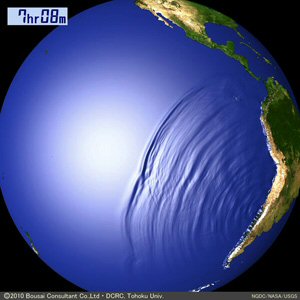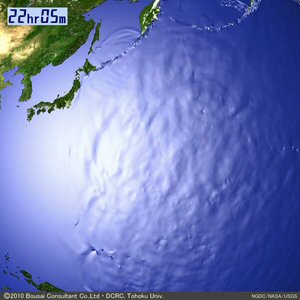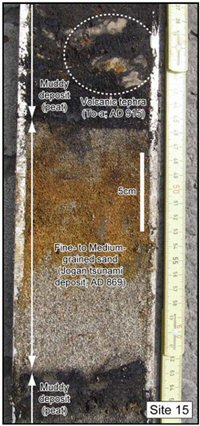--Please tell us about the contents of your research being conducted in Disaster Control Research Center (Tsunami Engineering).
| Prof. Imamura |
This research center is the only institution in the world where Tsunami
is studied with the engineered approach. Based on the principle of provision
and control of the disaster, we perform the field work in both Japan and
abroad, develop advanced numerical prediction system for Tsunami, and support
Tsunami disaster provisions as our main research activities. The tsunami analysis technology of this research center is being transferred internationally especially to countries where Tsunami damage may occur in the future. TIME(Tsunami Inundation Modeling Exchange) project is set as a core of this transfer. Tsunami analysis code developed by this laboratory has been transfered to more than 24 countries, 48 institutions, and are being used to reduce the the damage of Tsunami disaster. |
| Prof. Fumihiko Imamura, Disaster control center, Graduate School of Engineering, Tohoku University | Building of the research center |
--When did you decide to study the Tsunami disaster prevention ?
| Prof. Imamura |
I would never forget it. On May 26, 1983, the Middle Japan Sea Earthquake
occured off the coast of Akita prefecture.That was how I started the study
of Tsunami disaster prevention. I was a student of the departement of civil
engineering in Tohoku University at the time, and had surveyed the damage
of earthquake tsunami as a member of the investigation team for two weeks
carrying survey equipments. Around 100 people in Oga city and Noshiro city, which are on the coast of Sea of Japan, had died because of this earthquake. The numbers included tens of elementary school students who were visiting the coast. The damages done by Tsunami to these areas were shot by home video camera, and a number of shocking footages were broadcasted on TV. I didn't have the knowledge of sea having grown up in Yamashi prefecture called "Area without sea". Therefore, I was shocked coming in contact with the damage of Tsunami, and since then I decided to study tsunami and to start researching on Tsunami disaster prevention. |
--The code for Tsunami analysis program developed by the research center is evaluated as having the latest function in the world, and the code is used in the Tsunami analysis support service of FORUM8 by linking with the real-time virtual reality system "UC-win/Road". Could you explain what this program is.
| Prof. Imamura |
When the earthquake centered in the ocean bed occurs, the ground of sea
bed will upthrust and sink. The deformation of the sea surface by this
ground deformation is the mechanism of the generation of tsunami. Tsunami moves in a wide area just as the tsunami occurred off the coast of Chile, other side of the world, causes damage to Japan after traveling through the Pacific Ocean. Sometimes, it can travel 18,000 Km from the Southern Hemisphere to Northern Hemisphere. One of the characteristic of Tsunami is its speed, which is several hundred kilometers per hour. The Tsunami analysis code of the reseach center is developed to analyze the tsunami moving at a very high-speed in real-time. The calculus of finite differences of shallow-water equation was used for it. As for the input condition, the following elements are required : the information of the hypocenter including magnitude, depth, and position, the terrain data including the sea bed (elevation and position). As the earth rotates while tsunami moves within such a wide range, we are required to consider the effect of its rotation for the analysis of wave shape of tsunami, its energy, and the direction it is moving. Hence, tsunami analysis code considers "Coriolis force" representing the effect of self rotation. In addition, the code considers a theory of "wavenumber dispersion", which is usually not known among general public, to perform a more accurate estimation. We were finally able to use the wavenumber dispersion by taking advantage of the numerical error which are normally removed. |
--They are saying damage done by tsunami that was triggered by Great East Japan Earthquake on March of 2011 was beyond expectations.Professor Imamura, could please you give us your thoughts on this?
 |
 |
|
| Transmission of Chile Tsunami 2011(Documents provided by Mr.Fumihiko Imamura) | ||
--Was the result of research helpful in this Great East Japan earthquake?
| Prof. Imamura |
There are many people who may hear tsunami once in 1000 years and do not
understand.Then, the simulation result of tsunami is made into an animation
and visualize the situation of tsunami, and then it makes it easier for
ordinary people to understand. Last October, in Wakabayashi area in Sendai which suffered serious damage from this tsunami, the lecture meeting of tsunami disaster prevention was held using this simulation animation. About 300 people, such as local residents, the police, and the Self-Defense Force participated. People who saw whether what would happen if tsunami attacks the present town by simulation recognized the necessity of escaping to high location and that the eastern Sendai road is one of a few high area in Wakabayashi area. I heared that in this time's earthquake, there were about 200 people who were heading to the eastern Sendai road and was saved. Although there is no telling how many people among these had participated in the lecture meeting, I believe that it was useful to reduce the damage of tsunami. |
--Evacuation simulation is also being researched in Professor Imamura's laboratory. FORUM8 distributes EXODUS, evacuation simulation software. How do you think you can utilize tsunami evacuation analysis?
| Prof. Imamura |
We are doing a research on evacuation simulation that can predict human
behavior at the time when tsunami occurs, as a research in area of human
behavior. For evacuation simulator at a time of fire, we analyze how people
react and evacuate after seeing fire or smoke; however, as for tsunami,
when you see it coming it's too late to evacuate. Therefore, we analyze
the behavior of people who hears tsunami warnings. Memory and experience of a person will greatly affect when and where he/she will evacuate. For example, a person's perception of distance to the place of evacuation and the time it takes for him/her to get there after being instructed to "Evacuate to the designated area of evacuation on the mountain" will depend on his/her memory or experience. Those who know their way to the area of evacuation very well will have a feeling that place is very near, whereas, those who don't know very well on how to get there will feel that the place is very far away. We are researching on people's behavior during a disaster using a method of cognitive psychology. As compared to a map that is measured and created quantitatively, a map inside a person's brain has some distortion in terms of distance and direction. A simple method of finding the distortion in that kind of map is called "Cognitive map". In this method, we ask a person to draw a map illustrating a route from a particular point to the place of evacuation. When we ask several people to do this, we can find out that the direction and distance drawn by each person is different. In other words, time it takes for people to start evacuating and the route they take after hearing tsunami warning will vary depending on each of their memory and experience. There can be cases where the difference in this time can separate those that will survive from those that won't. By inputting this criteria of judgment (based on time it takes a person to start evacuating) to EXODUS, we think that analysis of tsunami evacuation can be realized. |
--Q. What did Mr. Imamura learn and find problem from the Great East Japan earthquake?
| Prof. Imamura |
Due to Tsunami in this time, everything was flown out. The size of flowing
items and the contents was far exceeding over our prediction. The big example
is vehicle. Previously, the flowing items were just like vessel, however,
in this Tsunami, the mass number of the vehicles was flown out and hit
into buildings and the glasses were broken as the disaster damage. Unusual
example that we never experienced before is the defense forest in coastal
area was flown out and carried into inside of the land as rubble. In addition, this earthquake caused multi-disaster which caused earthquake shake, Tsunami and land liquefaction simultaneously. Depending on kind of building, the design by considering external force had been done. However, the design has never considered only one factor, not multi factor. Thus, Tsunami hit buildings whose base was already weaken by liquefaction or earthquake shake, and then some of them were collapsed and some Tsunami defense walls were destroyed. |
| Damage condition in Onagawa town Concrete building collapsed by Tsunami(Photo provided by Mr. Fumihiko Imamura) |
Damage condition in Kisennuma city Ship coming in the urban area(Photo provided by Mr. Fumihiko Imamura) |
--Please tell me about the direction of your future research, etc.
| Prof. Imamura |
For this Great East Japan earthquake, although the specialist of an earthquake
or tsunami had provided 100% of their knowledge, various "unexpected"
things happened. Accordingly, it is difficult handle by the specialist
in only one field, and I think it required for specialists, such as geology,
a history of the earth, history, to cooperate to treat it. The Imamura laboratory also join the development of the next-generation supercomputer "KEI" under development as the member. Forum 8 is planning to offer Supercomputer Cloud Service using KEI. In Imamura laboratory, in collaboration with Forum 8 positively, we would like to work on the publicity of tsunami analysis code through Supercomputer Cloud Service and treatment to the parallel processing adjusted to the supercomputer Moreover, since tsunami is transmitted into the sea and brings damage to each country, international cooperation is indispensable to tsunami disaster prevention. Then, I also wish to perform the activity about development and transfer of international tsunami disaster prevention technology continuously. |
--Finally, what is Professor Imamura's present dream?
| Prof. Imamura |
That is restoration of disaster area suffered by Great East Japan earthquake revives. |
--Thank you very much.
(Coverage/Writing : Ryuta Ieiri)
|
||||||||||

